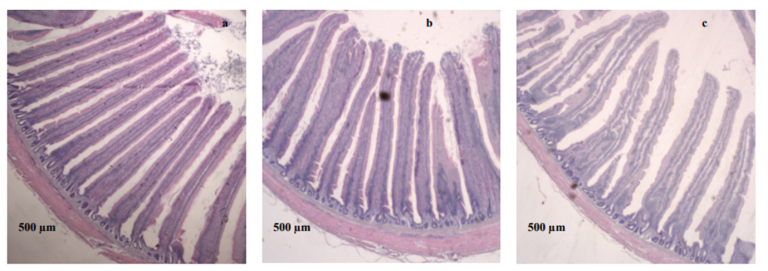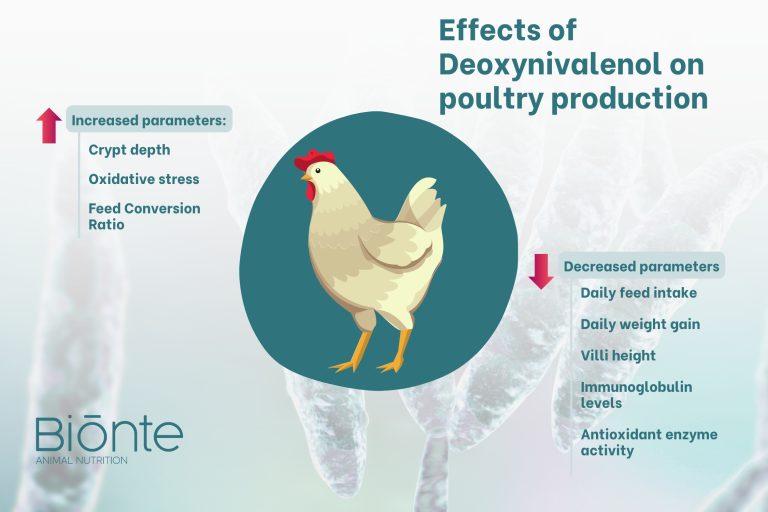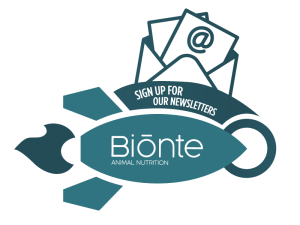Introduction
The safety and quality of poultry feed is a crucial aspect in the poultry industry. The contamination of feed with mycotoxins, such as deoxynivalenol (DON), poses significant challenges, affecting both poultry production performance and gut health. This mycotoxin, produced by fungi of the genus Fusarium, proliferates in hot and humid conditions, and is usually found in grains commonly used in poultry diets, such as corn and wheat.
Therefore, based on a meta-analysis of the studies carried out, the main effects that this mycotoxin can generate in the poultry sector have been described (Chala et al., 2024).
Performance
The presence of DON in feed can have a direct impact on feed consumption and utilization. Studies have shown that birds exposed to DON exhibit a reduction in daily feed intake (ADFI) and a decrease in daily weight gain (ADWG), resulting in lower growth efficiency and productive performance (Awad et al. 2013). This is because DON affects the digestion and the absorption of nutrients, decreasing the availability of energy for growth.
In addition, the feed conversion ratio (FCR) worsens in birds fed with feed contaminated by DON, which means that more feed is needed to achieve the same weight gain as in birds not exposed to this toxin. This represents an economic challenge for producers, as it increases production costs.
Gut Health
The small intestine of birds is critical for digestion and absorption of nutrients, and exposure to DON directly affects its structure and functionality. This mycotoxin causes atrophy of the intestinal villi, decreasing the surface area available for nutrient absorption and thus affecting the efficiency of feed utilization. In addition, studies have shown that DON increases the depth of crypts in the intestine, indicating increased cell turnover and possible tissue damage in response to the toxin (Wan et al., 2022).
The result of these effects is a reduction in the integrity of the intestinal barrier, which facilitates the entry of pathogens and increases the risk of gastrointestinal infections in poultry, generating additional losses in production performance and animal health.

Image 1. The Impact of the Fusarium Mycotoxin Deoxynivalenol on the Health and Performance of Broiler Chickens (Control,1 mg DON/Kg, 5 mg DON/Kg diet)
Immune system
Exposure to DON also affects the immune system of poultry. This mycotoxin has been observed to reduce the levels of immunoglobulins such as IgA, IgG, and IgM, which are key in defending against infection (Riahi, et al., 2021). Fewer of these immunoglobulins leave birds more vulnerable to infection, particularly in the digestive system, where they constantly face pathogens.
Oxidative Stress and Antioxidants
Oxidative stress is another problem associated with DON exposure. Mycotoxin increases the production of free radicals in the gut, which depletes natural antioxidant defenses, such as catalase (CAT) and glutathione peroxidase (GPx). This imbalance between pro-oxidants and antioxidants leads to damage to intestinal cells, further impairing nutrient absorption and the animal’s overall well-being (Jena et al., 2023).
Parameters that are increased:
- Crypt depth: Increases in response to tissue damage, indicating cell regeneration in the intestine.
- Oxidative stress: Increased production of oxygen free radicals (ROS), generating cell damage.
- Feed Conversion Ratio (FCR): More feed is required to achieve the same weight gain in affected birds.
- Immunoglobulin levels (IgA, IgG and IgM): They decrease, affecting the immune response and increasing susceptibility to infections.
Parameters that are decreased:
- Daily feed intake (ADFI): Affected birds consume less feed.
- Daily Weight Gain (ADWG): Reduction in growth and weight gain.
- Height of the intestinal villi: The atrophy of the villi reduces the surface area for absorption of nutrients.
- Antioxidant enzyme activity: Enzymes such as catalase (CAT) and glutathione peroxidase (GPx) are reduced, limiting the defense against oxidative stress.

Conclusion and Preventive Measures
DON contamination in poultry feed presents a critical challenge in modern poultry production. Implementing control strategies, such as proper storage practices and use of antioxidant or prebiotic additives in the diet, can help reduce the detrimental effects of this toxin. In addition, regular mycotoxin testing and active monitoring of feed quality, are essential steps to protect bird health and improve production performance in the poultry sector.
In conclusion, understanding and mitigating the impact of mycotoxins such as DON is critical to the sustainability of the poultry industry and to ensure food safety in products derived from birds.



